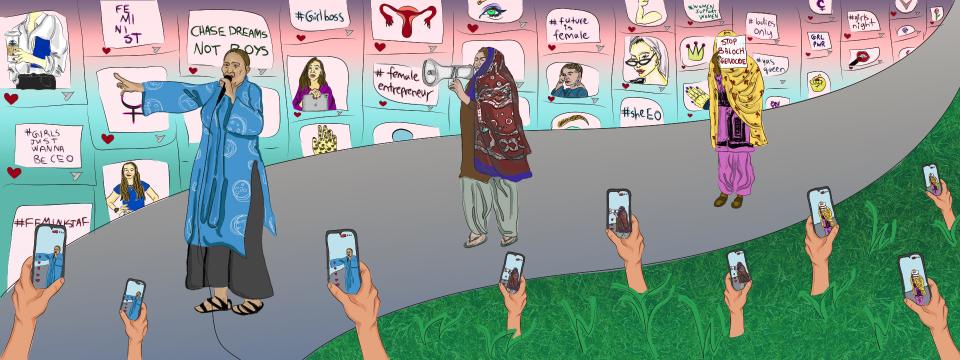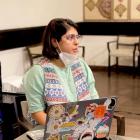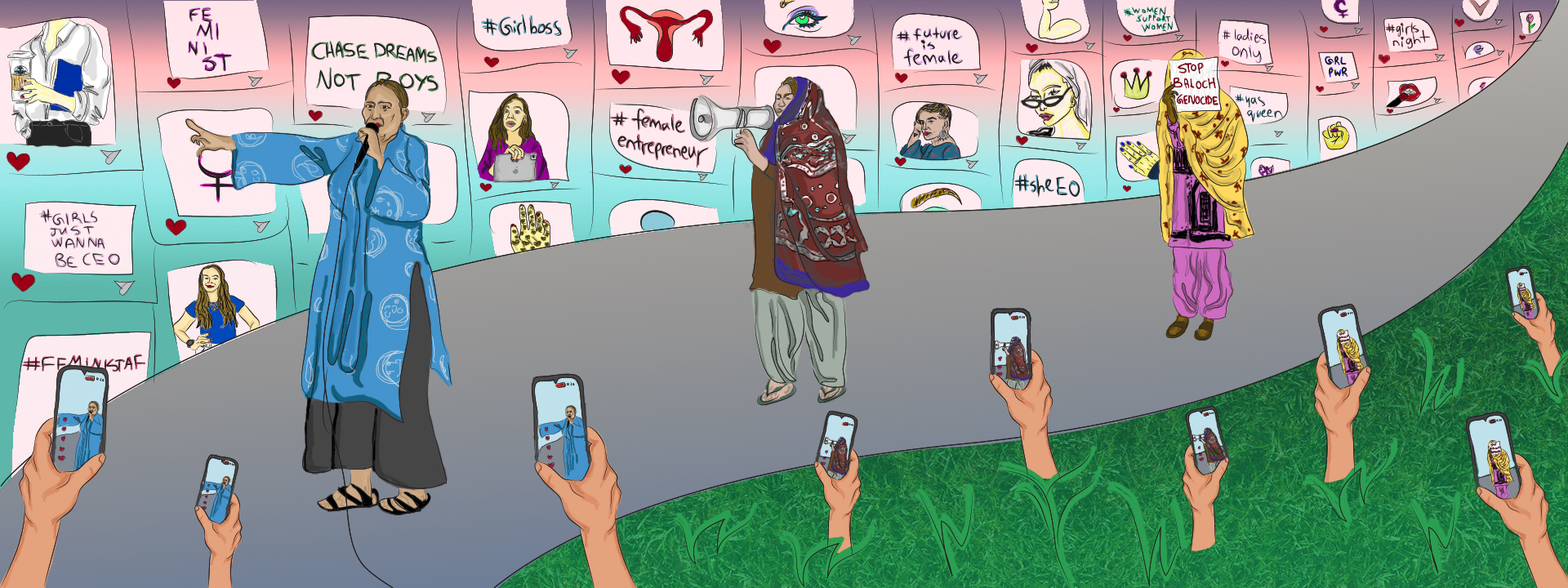
Commitment to Creativity. Illustration by MINELLE.V. for GenderIT.
This two-part series critically explores the interrelation between art and politics in the online manifestations of Pakistan’s feminist movement. You can read the second part here.
THE POLITICS OF ONLINE ART
Sana*, a woman who runs a grassroots charity initiative with presence on Instagram and YouTube, called me recently to ask for financial support that could help her amass subscribers for her YouTube channel so she could finally monetise it. She told me of her decision to go to Karachi so she could meet a family of YouTube content creators that would help her gain more subscribers — for a price. “They show you how they make content and gain popularity on YouTube, and then they give you subscribers, but they charge you for all this,” she said.
I dissuaded her from this endeavour, while listing to her the benefits of an organic follower growth. I also expressed my discomfort at the family asking for money so they could “give” her subscribers. It sounded like a scam, especially since YouTube’s algorithm is also resistant to inorganic views.
“But then I will never get to a thousand followers!” Sana protested. “It is going to take me years to get the kind of following I need to make money online.” And I could not help but think that she was right. Followers are now a part of one’s cultural capital: an unexchangeable currency that takes people years to build, even if they may not be doing so consciously.
She continued, “Whenever I make a call for donations online, hardly anyone responds. I sometimes get funds when you or someone else who is affluent shares my posts, but that does not happen as often as it should. The right people do not see my content on social media.”
Followers are now a part of one’s cultural capital: an unexchangeable currency that takes people years to build, even if they may not be doing so consciously.
I understood immediately that she was talking about her position as a working class changemaker on the social media platforms she used, and the class exclusivity therein. She did not have the kind of network or following that could successfully promote her work so that she could get the funds she needed to help people in her community.
Sana’s work, in a sense, was rendered invisible to those who had the resources to fund her initiative and yet did not include her in their carefully curated online world. How could Sana scale beyond her current level of social capital on an already uneven playing field?
Art as an Optical Illusion
According to the academic Nicky Falkof, the competitive nature of social media platforms promises access to significant social and cultural capital to Internet users, “which can be invaluable for many in the unequal context in which we live.” She notes that in order to succeed in the high stakes online environment on these platforms, many people carefully curate the identities and idealised selves that they display online.
Inversely, aesthetic values incorporate and appeal to identity-based stereotypes and hierarchies. Tatum Dooley posits, “Where ‘lifestyle’ might once have referred to one’s general mode of living, it now refers to the fact that even the smallest detail of one’s everyday reality is capable of being documented, and thus subject to the same aesthetic as one’s way of living.” Influencers on Instagram, TikTok or YouTube, have the power to dictate their followers’ purchases, not only in terms of desirable appearances or home décor, or even curated experiences, but also in less tangible qualities, such as belief systems. It must look, to their audience, like they are living the good life: a life that is worth coveting.
Nicky explains that within the existing hegemonic structures of online spaces, “many people appear to be exercising their freedom of choice as neoliberal citizens within a post-feminist setting.” She observes that despite the promises of choice, their performances of selfhood are “powerfully” restricted by “capitalist ideas about aspiration, success, knowledge, and even politics.” Simply put, Sana’s work online did not fit into the language and the aesthetics of online platforms, which can be out-of-touch, classist and hyper-curated.
So how does her predicament throw her in sharp contrast to progressive organisers who do have the requisite visibility to build movements online? And if our work as organisers purports to be for the masses, who are we actually in a conversation with?
There is often talk about performative activism, virtue signalling and the aestheticization of political content in online spaces that suggests that political messages are rendered frivolous in the face of the grave circumstances that they are trying to garner attention towards. Despite the good intention of wanting to amplify the struggles of marginalised communities, are we actively listening to the voices of said communities by the oversimplification of politics online? Neon, prismatic shimmers, filters, and glow decorate our social media feeds. It is no surprise that the visual language that we associate with political work online gets caught in this effervescent trap. Instagram is peppered with social justice content featuring bold words, minimalist Canva graphics and palatable messaging.
The algorithmic apartheid perpetuated by corporate online platforms privileges a "posh" – upper class and urban – aesthetic, right down to the affordances presented by high-end phones that offer better pictures and videos. The inherent privilege bias of Pakistan’s 'content creation' economy reveals the consumption patterns that social media platforms encourage. These platforms do not attach much commercial value to the work of people like Sana, because her account lacks the obvious markers of affluence that corporations piggyback on to sell their wares.
The algorithmic apartheid perpetuated by corporate online platforms privileges a "posh" – upper class and urban – aesthetic, right down to the affordances presented by high-end phones that offer better pictures and videos.
Technology is reorienting our movements to correspond to its own interests, rearranging our organising according to whatever increases engagement and likes. Nevertheless, the popularity of arts and culture in online spaces cannot be overlooked.
Art as Revolutionary Praxis
Art cannot be insulated from the actions of an emancipatory revolutionary force. The functions and place of art are central to the work of progressive movements and cannot be dismissed. This is why digital virtuality in art possesses such a utopian and prefigurative character: multidimensional situatedness as a claim on the future rather than the present.
Amna Mawaz Khan, a performance artist and political worker, is used to people denigrating her for being a classical dancer. Nevertheless, she has consistently centred art as an intrinsic part of the political work she does. “It is unfortunate that we, as progressives, do not own our ideas. We are always on the backfoot, on the defence. Art is a counterpower; it is intrinsic for not only political liberation, but also for our politics to reach people."
Mural of Amna Mawaz Khan made by Akeli Larkiyan (lone women) for Aurat Azadi Jalsa 2022, Islamabad
The connection between art and feminism is undeniable. Cultural modes of political protest are subversive simply because they are resisted; we have seen art with political connotations being censored in Pakistan since time immemorial. In the 1980s, artists painted to subvert state control. As noted by Salima Hashmi, a Pakistani artist, “Not a single woman artist took up calligraphy or changed her mode of working to bring it in line with official state policy.” Artists of the time produced works that represented their lived experiences of surviving Zia-ul-Haq’s dictatorship, and used symbolism to mask the anti-establishment messages that they wanted to communicate through their work.
Aurat March Lahore, 2019. Source: Arif Ali/AFP
The feminist resistance in Pakistan has been many things: critical, subversive, but more importantly, creative, in its fight against the state. What is different about feminist art now is that it has become more prominent in online spaces, and therefore given the movement an unmistakable visual imprint.
Modern-day feminism in Pakistan has been undeniably aesthetic in its effects. The Aurat (Azadi) Marches (feminist marches held every year on 8 March) across Pakistan have finally brought the discussion of sexuality and body politics to public places in the form of irreverent placards brought by protestors who call out the institution of family as the primary site of violence, refusing to show restraint in the anger and passion they articulated onto their placards.
Instagram account @ProtestandArt archives the usage of art in progressive movements in Pakistan
Art as Fighting Back
Nida Mushtaq, an organiser who employs arts and creative tools for social justice, is a part of Akeli Larkiyan (Lone Women), a formation of feminist artists, thinkers and dreamers who make street art for Aurat Azadi March. She says, “When you live in such a violent place, when your days are shaped by violence, it is important to have as many reminders of beauty and possibility as possible, as we express ourselves through art. We make art in the very same spaces we experience violence in.” This sort of art strengthens progressive movements and represents, according to Nida, our collective desire for change; art is at the core of how movements are built.
What is different about feminist art now is that it has become more prominent in online spaces, and therefore given the movement an unmistakable visual imprint.
Nida elaborates, “This is the language we use to make our work visible in a country where lies, erasure and loss are so common for us.” Hence the need to tell our stories over and over again, whether they are removed or not, becomes all the more pertinent.
This is how they keep erasing us from our city, this country; from history itself. This mural was a testament to our politics, existence, labor & creativity. Now it's a symbol of our erasure. We wanted to bring color to this city & this is the response we got #AuratAzadiMarch2020 pic.twitter.com/w24BvvYx4P
— Aurat Azadi March Islamabad (@AuratAzadiMarch) March 3, 2020
In 2020, hardliners from Sipah-e-Sahaba and clerics from Lal Masjid, two extremist right-wing groups, defaced the mural made by Akeli Larkiyan, sending a terrifying message to feminists that their existence will not be tolerated on the streets of Islamabad. Even though violence is the only language understood by some of the naysayers of the movement, feminist organisers keep articulating the future they wish to see through art, in the face of erasure.
The anguish of Islamabad's women turns a defaced mural into a portal. It escapes into the world of Madarshahi, where all their stolen dreams reside. pic.twitter.com/yAVfl3pWkO
— Faizan. (@thoraoffbeat) March 4, 2020
Each spring, a group of feminist artists & dreamers gets together under the @AuratAzadiMarch umbrella to do street art in Islamabad.We call ourselves the Akeli Larkian Group (to pay homage to our first mural in G6 which was defaced by extremists).In 2022 our art looked like this:
— Areej (@AreejYasin) April 25, 2022
As a result, Akeli Larkiyan designated a tree at the Aurat Azadi Jalsa earlier this year for women and non-binary people to write their hopes and dreams, which were later folded into small pieces of fabric and then tied to the branches of the tree.
According to Nida, “At the 2022 jalsa, Akeli Larkiyan decorated a beautiful willow tree, meant to be an imaginative space. We asked people to write their thoughts and dreams on small pieces of paper that contained the prompts (above) to help them imagine what kind of a feminist utopia they wished to see.”
اگر تم اپنی آواز بلند کر سکتی تو کیا کہتی؟
If you could raise your voice, what would you say?
اگر تم اکیلی باہر نکل سکتی تو کہاں جاتی؟
If you could leave the house alone, where would you go?
اگرتم وقت کی تابع نہ ہوتی تو تم کہاں ہوتی؟
If you were not beholden to time, where would you be?
اگر تمہاری کوئی صنفی پہچان نہ ہوتی تو تم کون ہوتی؟
If you had no gender identity, who would you be?
اگر تمہارے اوپر ساری دنیا کی نظریں نہ ہوتی تو تم کیا کرتی؟
If the eyes of the entire were not upon you, what would you do?
اگر گھریلو کام میں سب اپنی ذمہ داری نبھاتے تو تم اپنی ذات کے لیے کیا کرتی؟
If everybody did their share of household work, what would you do for yourself?
The Urdu prompts that were used by Akeli Larkiyan to make people think about their hopes and dreams.
Nida further proclaims, “Political art should not be sidelined or treated like an add-on. It is genuine political labour. This is exactly what we are fighting for: to be able to have these kinds of spaces, to experience moments of joy, to express ourselves candidly, to be able to grieve but not to fall down the cracks of the world, to live our lives as full humans. This is why we do politics; what our movements are for. We cannot give up on the very tiny possibilities we can strive for.” Hence, under patriarchal capitalism, art can become an expression of a desire to reclaim public space. The feminist cities we attempt to imagine signify sites of collective experience as well as alienation.
Feminist art becomes meaningful when it is produced by those who struggle within the peripheries of cities and border-states, often representing the most marginalised voices that share stories of trauma, violence, and subversion. Their paints and artistic materials become the tools for challenging the privatisation of spaces they see as rightfully theirs: spaces that have been commercialised and sanitised courtesy of state and developmental control.
Such art in and of itself signifies a desire to move toward a participatory politics. When we are hindered from shaping and being in dialogue with the spaces that surround us, a desire to take these spaces back, to reinvent them, manifests. The irreverent feminist art we make is indicative of a desire for a more participatory, less gatekept world.
- 1832 views








Add new comment